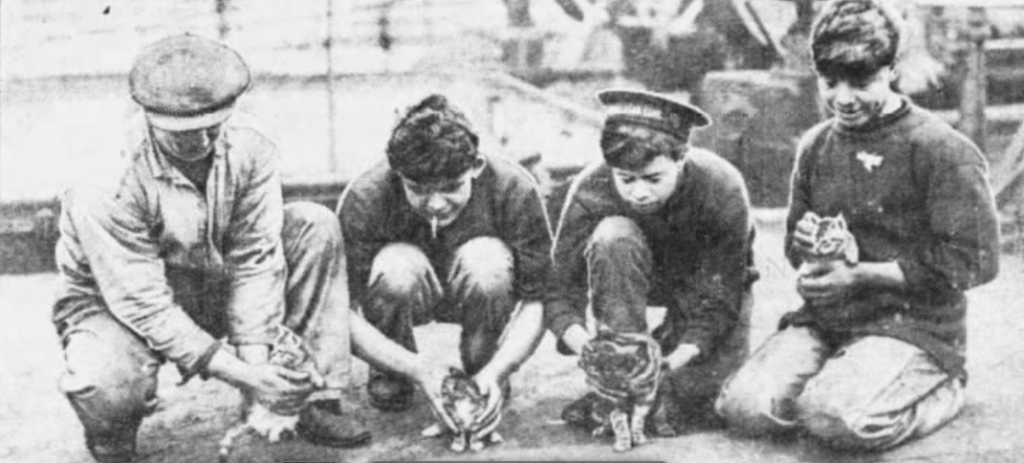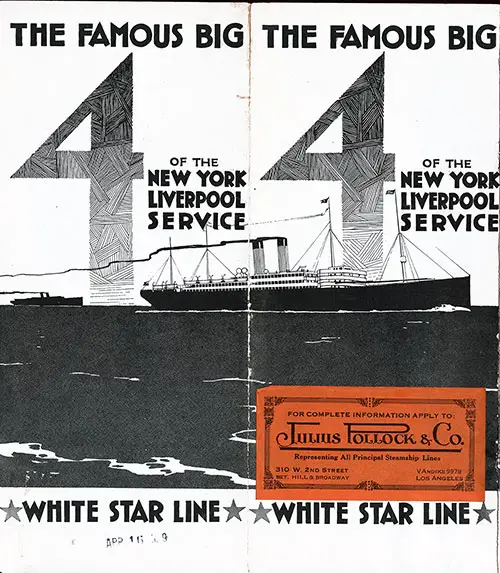Cats in the Mews: December 26, 1922

On this day in 1922, Minnie, the ship cat of the RMS Cedric, was honored for saving 36 lives (herself and her three kittens). The rescue took place during a severe storm in the Atlantic Ocean that disrupted Atlantic shipping and damaged or completely destroyed numerous steamships heading toward New York.
According to the Daily News, Minnie had presented her sailor friends with a litter of kittens two days before the RMS Cedric left Liverpool. During the storm, Seaman Blackburn took the kittens for a bath (I have no idea why he would do this).
Minnie thought he had carried the kittens up to the deck, so she went up the hatchway in search of them. A giant wave rushed over the ship, catching Minnie in the flood of water. She was almost swept overboard, but she was able to sink her claws into a rope ladder and hold on for dear life.

When Blackburn heard that Minnie was on deck, he went up to get her. As he was reaching down to grab her, another wave broke over the ship, and man and mother cat came perilously close to being tossed into the sea.
Luckily, the two were able to make it safely back down below decks. The ship arrived at Pier 59 (Chelsea Piers) a few days late, but there were no reported deaths or injuries, human or feline.
Numerous Ships Lost or Delayed

The SS Cedric of the White Star line, known as a storm fighter, suffered less damage than many other ships during what was called one of the most severe storms in many years. The twin-screw steamships Celtic, New Columbia, Zeeland, Carmania, and United States all bore battle signs when they berthed in New York the day after Christmas. On all of the ships, lifeboats had been swept away, railings were smashed, and decks were wiped clean of anything that hadn’t been lashed down tightly.
The RMS Cedric was in the best condition, but the white salt lines high up on her stacks showed that the ship had gone through a horrendous gale. According to the sailors, at times the wind velocity was measured at 100 miles per hour in what appeared to be a succession of storms. Captain G.R. Metcalfe told the press it was the worst storm he had ever experienced in his twenty years at sea.
Passengers on the ships also reported a fearful voyage; those who were able and courageous enough to watch “the boiling sea” through the storm ports declared it “the most magnificent spectacle they had ever seen, with towering waves, flung spray and foaming water coursing over the decks.”
The Famous Big Four

The famous Big Four of the White Star Line were the largest steamers sailing regularly between New York and Liverpool, calling at Queenstown both eastbound and westbound. The Adriatic and the Baltic were each 725 feet long; the Cedric and the Celtic were 700 feet in length. All four ships were launched before White Star introduced the Titanic and the Olympic.
From a White Star Line brochure dated April 16, 1909:
TRAVELERS who frequently cross the Atlantic nearly always acquire a preference for a specific ship, admiring it, perhaps, for many good qualities, such as steadiness in all weathers, reliable comfort, splendid cuisine, pleasant officials and efficient staff, or any of a dozen other equally good reasons.
Everyone of the White Star Line’s famous Big Four—the favorite mammoth steamers ADRIATIC, BALTIC, CEDRIC and CELTIC—can boast of hosts of such passengers who choose these vessels for journey after journey, knowing that upon them—in any class—will be found precisely the satisfactory service and the perfection of courtesy they have so thoroughly enjoyed before.
They are of robust and sturdy build, with graceful, stately lines, and if there is one comment about them heard more often than another, it is that these vessels are ‘so very steady.'”

Incidentally, on April 15, 1912, while in seclusion in the doctor’s cabin on Carpathia, Bruce Ismay reportedly sent a wireless message to the White Star Line’s New York office, requesting the RMS Cedric be held until Carpathia’s arrival. That way, the Cedric could transport Titanic’s surviving officers and crew back to England.
However, Cedric departed from Pier 59 at noon on April 18, almost ten hours before Carpathia docked with the survivors.



